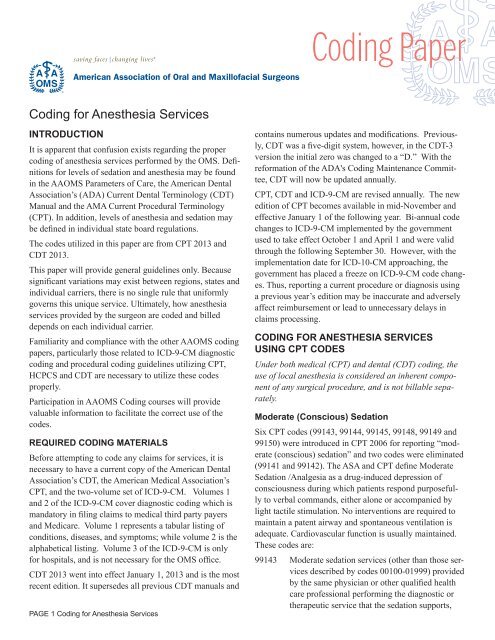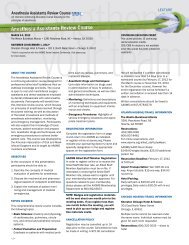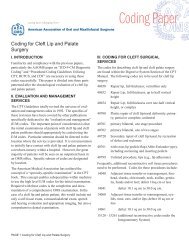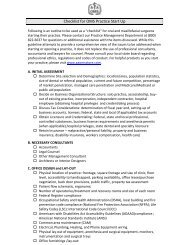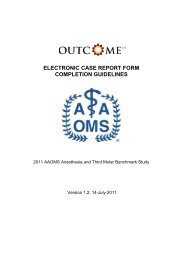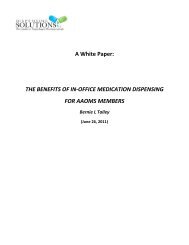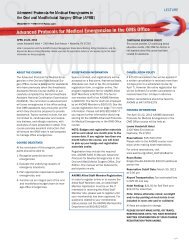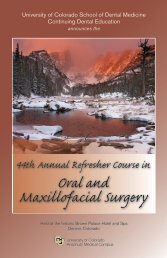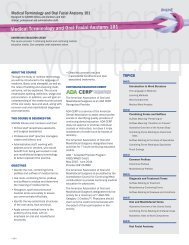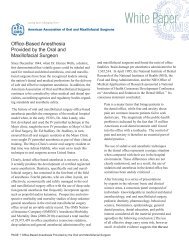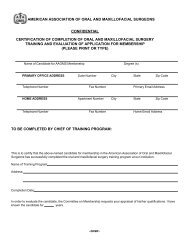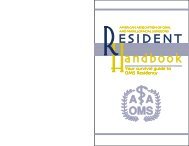Coding for Anesthesia Services - American Association of Oral and ...
Coding for Anesthesia Services - American Association of Oral and ...
Coding for Anesthesia Services - American Association of Oral and ...
You also want an ePaper? Increase the reach of your titles
YUMPU automatically turns print PDFs into web optimized ePapers that Google loves.
equiring the presence <strong>of</strong> an independent trainedobserver to assist in the monitoring <strong>of</strong> thepatient’s level <strong>of</strong> consciousness <strong>and</strong> physiologicalstatus; younger than 5 years <strong>of</strong> age, first 30minutes intra-service time99144 age 5 years or older, first 30 minutes intraservicetime+ 99145 each additional 15 minutes intra-servicetime (List separately in addition to code <strong>for</strong>primary service); note that this is an add-oncode <strong>and</strong> must be used in conjunction with99143, 9914499148 Moderate sedation services (other than those servicesdescribed by codes 00100-01999), providedby a physician or qualified health care pr<strong>of</strong>essionalother than the health care pr<strong>of</strong>essionalper<strong>for</strong>ming the diagnostic or therapeutic servicethat sedation supports; younger than 5 years <strong>of</strong>age, first 30 minutes intra-service time99149 age 5 years or older, first 30 minutes intraservicetime+ 99150 each additional 15 minutes intra-servicetime (List separately in addition to code <strong>for</strong>primary service); note that this is an add-oncode <strong>and</strong> must be used in conjunction with99148, 99149In CPT 2013 there are many codes that have a “bullseye”designation 8 in front <strong>of</strong> the code. These codes havemoderate (conscious) sedation by the surgeon included inthe RVUs <strong>for</strong> that code. None <strong>of</strong> these codes are currentlyutilized by the OMS.Deep Sedation / General <strong>Anesthesia</strong>To report general anesthesia/deep sedation providedby the surgeon per<strong>for</strong>ming the surgical procedure, it isnecessary to add modifier “-47” to the surgical procedurecode. Modifier “-47” is not used as a modifier <strong>for</strong> theCPT <strong>Anesthesia</strong> Codes (00100 - 00352 <strong>for</strong> head <strong>and</strong> neckprocedures) as these reflect anesthesia services providedby an individual other than the operating surgeon. (Note:The five digit modifier <strong>for</strong>mat was eliminated from CPTbeginning in 2003 making the previous 09947 obsolete).For example, closed reduction <strong>of</strong> a m<strong>and</strong>ibular fractureper<strong>for</strong>med in the <strong>of</strong>fice under deep sedation / general anesthesiawould be reported as: 21451 <strong>for</strong> the procedure, with21451-47 as a separate line item <strong>for</strong> the anesthesia.Some insurance companies will permit surgeons to reporttheir anesthesia services by utilizing codes from the<strong>Anesthesia</strong> chapter <strong>of</strong> the CPT Manual. Such anesthesiaservices are reported by the use <strong>of</strong> the anesthesia five digitprocedure code plus the addition <strong>of</strong> a physical status modifier.CPT codes 00100 through 00352 are the anesthesiacodes <strong>for</strong> the head <strong>and</strong> neck region. Unless advised otherwiseby a carrier, these codes are intended to be reportedby a provider administering anesthesia <strong>for</strong> the operatingsurgeon, or overseeing a CRNA. In either case, these codesare not generally used to report operator administeredanesthesia.The surgeon may be able to bill <strong>for</strong> supply <strong>of</strong> the anestheticagent, as well as possibly <strong>for</strong> IV antibiotics, analgesics<strong>and</strong> anti-inflammatory agents. The CPT supply code is99070. Some insurance companies may prefer the appropriateHCPCS Level II code representing the drugs administered(J codes).<strong>Anesthesia</strong> Relative ValuesAccording to the <strong>American</strong> Society <strong>of</strong> Anesthesiologists(ASA) Relative Value Guide, a “Basic Value” is assignedto the anesthetic management <strong>of</strong> most surgical procedures.This “Basic Value” includes “all usual anesthesia services,”except <strong>for</strong> the time actually spent in anesthesia care<strong>and</strong> any modifiers. “Usual anesthesia services” includesusual pre- <strong>and</strong> post-operative visits, administration <strong>of</strong> fluids<strong>and</strong>/or blood products incident to anesthesia care, <strong>and</strong>the interpretation <strong>of</strong> noninvasive monitoring (e.g., ECG,temperature, blood pressure, oximetry, capnography).When more than one surgical procedure is per<strong>for</strong>medduring a single anesthetic, the “Basic Value” would be that<strong>of</strong> the procedure which has the highest unit value.In addition to the ”Basic Value,” additional modifiers areused to accurately code <strong>and</strong> bill <strong>for</strong> services. These modifiersare primarily the “Modifying Units” [see below] <strong>and</strong>“Time Units.” Other modifiers exist, but have little or norelevance to practicing OMS’s.Physical Status Modifiers<strong>Coding</strong> PaperPhysical Status Modifiers should be appended to any CPTanesthesia chapter code. They are indicated with the initialPAGE 2 <strong>Coding</strong> <strong>for</strong> <strong>Anesthesia</strong> <strong>Services</strong>
letter “P” followed by a single digit from 1-6 as listedbelow:P1 -P2 -P3 -P4 -P5 -P6 -Normal healthy patient.Patient with mild systemic disease.Patient with severe systemic disease.Patient with severe systemic disease that is aconstant threat to life.Moribund patient, not expected to survive withoutthe operation.Declared brain-dead patient whose organs arebeing removed <strong>for</strong> donor purposes.These six levels are consistent with the ASA classification<strong>of</strong> physical status <strong>and</strong> are added to the basic anesthesiacode in the same fashion as any CPT modifier. (Example:00190 - P2)Qualifying CircumstancesThough technically not modifiers, these codes serve todescribe anesthesia services under unusual or difficultcircumstances. Such unusual circumstances <strong>and</strong> servicesmay qualify <strong>for</strong> additional reimbursement when reportedin addition to the anesthesia code. These codes are notreported alone, but in addition to the qualifying anesthesiaprocedure or service. More than one CPT code may beused.+99100 <strong>Anesthesia</strong> <strong>for</strong> patient <strong>of</strong> extreme age, under oneyear or over 70.+99116 <strong>Anesthesia</strong> complicated by utilization <strong>of</strong> totalbody hypothermia.+99135 <strong>Anesthesia</strong> complicated by utilization <strong>of</strong> controlledhypotension.+99140 <strong>Anesthesia</strong> complicated by emergency conditions(specify).[Emergency is defined as existing when delay in treatmentwould lead to a significant increase in the threat to life orbody part.]Reporting TimeThe other factor to consider when billing <strong>for</strong> anesthesiaservices is time. <strong>Anesthesia</strong> time begins when the anesthesiaprovider begins to prepare the patient <strong>for</strong> induction<strong>Coding</strong> Paper<strong>of</strong> anesthesia (typically when the intravenous access isestablished) <strong>and</strong> ends when he/she is no longer in personalattendance (i.e., when the patient is safely placed underpostoperative supervision). This is expressed as “TimeUnits.” The basic “Time Unit” is generally considered tobe 15 minutes. However, carriers may vary in how theydefine “Time Unit.” For example, 10 minutes could beconsidered the basic unit <strong>for</strong> some carriers. Be sure to verifywith specific carriers how they define such time units,<strong>and</strong> how they would like time reported. The HIPAA ElectronicTransaction St<strong>and</strong>ard 5010 no longer accepts units,<strong>and</strong> requires the reporting <strong>of</strong> total anesthesia time. Thetotal time is coded on the claim <strong>for</strong>m under the column<strong>for</strong> “Units.” The <strong>of</strong>ficial instructions <strong>for</strong> completing theCMS 1500 are maintained by the National Uni<strong>for</strong>m ClaimCommittee (NUCC). The most recent instructions provideguidance on reporting time above the date field in box 24<strong>of</strong> the claim <strong>for</strong>m. For a visual example, visit nucc.org <strong>and</strong>download the most current instructions.WHAT ABOUT MEDICARE?Under Medicare, deep sedation/general anesthesia iscovered only <strong>for</strong> Medicare-covered procedures, <strong>and</strong> only ifadministered by another doctor or nurse anesthetist underthe supervision <strong>of</strong> another doctor. Medicare presentlybundles the payment <strong>for</strong> deep sedation/general anesthesiaadministered by or under the supervision <strong>of</strong> the operatingsurgeon.Thus, general anesthesia/deep sedation by surgeon isnon-covered <strong>and</strong> non-billable <strong>for</strong> Medicare coveredservices. If, however, anesthesia is billed by a separate individual<strong>for</strong> a Medicare-covered service, time should be reportedin accordance with policies <strong>of</strong> your local MedicareAdministrative Contractor <strong>and</strong> the current instructions set<strong>for</strong>th by the National Uni<strong>for</strong>m Claim Committee availableat http://www.nucc.org.Moderate sedation by the surgeon, on the other h<strong>and</strong>, iscarrier priced. This allows individual Medicare Part Bcarriers discretion regarding approval <strong>and</strong> payment rates.PAGE 3 <strong>Coding</strong> <strong>for</strong> <strong>Anesthesia</strong> <strong>Services</strong>
DENTAL CODING FOR ANESTHESIAUnder both medical (CPT) <strong>and</strong> dental (CDT) coding,the use <strong>of</strong> local anesthesia is considered an inherentcomponent <strong>of</strong> any surgical procedure, <strong>and</strong> is not billableseparately.Significant differences exist between anesthesia billing underCPT <strong>and</strong> CDT. Notable among these are the absence<strong>of</strong> modifiers <strong>and</strong> the “Time Unit” concept. CDT does notdistinguish between operator administered anesthesia <strong>and</strong>that provided by another practitioner. The concepts <strong>of</strong>facility, supplies <strong>and</strong> materials are also inherently differentin dental <strong>and</strong> medical billing. It is important to keep thesedifferences in mind when coding.When submitting anesthesia charges to a dental insurancecarrier, the following CDT 2013 codes should be used:D9220 deep sedation/general anesthesia - first 30minutesD9221D9230D9241D9242D9248deep sedation/general anesthesia - eachadditional 15 minutesanalgesia, anxiolysis, inhalation <strong>of</strong> nitrous oxideintravenous conscious sedation/analgesia – first30 minutesintravenous conscious sedation/analgesia – eachadditional 15 minutesnon-intravenous conscious sedationDEFINING START AND STOP TIMEAs noted, anesthesia start time commences when the anesthesiaprovider initiates the appropriate anesthesia protocol<strong>and</strong> remains in continuous attendance <strong>of</strong> the patient. <strong>Anesthesia</strong>time ends when the anesthesia provider can safelyleave the patient under postoperative supervision. Thus,anesthesia services <strong>and</strong> time are considered completedwhen the patient may be safely left under the observation<strong>of</strong> a trained anesthesia assistant, <strong>and</strong> the doctor may safelyleave the room to attend to other duties.Additional CDT anesthesia codes exist, but do not applyto anesthesia utilized in conjunction with a procedure.These codes are:D9210D9211D9212local anesthesia not in conjunction with operativeor surgical proceduresregional block anesthesiatrigeminal division block anesthesiaD9215 local anesthesia in conjunction with operative orsurgical procedures<strong>Coding</strong> PaperUSING DENTAL CODES ON MEDICAL CLAIMSIn general, CPT codes are not used on ADA <strong>for</strong>ms <strong>and</strong>CDT codes are not used on CMS 1500 (Medical) <strong>for</strong>ms.However, some medical carriers may direct that you useCDT codes on a CMS 1500 <strong>for</strong>m <strong>for</strong> “dental” procedureswhich do not have an applicable CPT code (e.g. thirdmolars). In those situations, they may also request use <strong>of</strong>CDT anesthesia codes.The presence <strong>of</strong> an anesthesia code, or any procedure code,does not guarantee payment <strong>for</strong> these services. It is crucial<strong>for</strong> the OMS practitioner <strong>and</strong> his/her staff to underst<strong>and</strong>the intricacies <strong>of</strong> reimbursement <strong>for</strong> anesthesia services byeach carrier, managed care organization <strong>and</strong> Medicare.Note: This paper should not be used as the sole reference in coding.Both diagnosis <strong>and</strong> treatment codes change frequently, <strong>and</strong> insurancecarriers may differ in their interpretations <strong>of</strong> the codes.<strong>Coding</strong> <strong>and</strong> billing decisions are personal choices to be made by individualoral <strong>and</strong> maxill<strong>of</strong>acial surgeons exercising their own pr<strong>of</strong>essionaljudgment in each situation. The in<strong>for</strong>mation provided to you inthis paper is intended <strong>for</strong> educational purposes only. In no event shallAAOMS be liable <strong>for</strong> any decision made or action taken or not takenby you or anyone else in reliance on the in<strong>for</strong>mation contained in thisarticle. For practice, financial, accounting, legal or other pr<strong>of</strong>essionaladvice, you need to consult your own pr<strong>of</strong>essional advisers.This is one in a series <strong>of</strong> AAOMS papers designed to providein<strong>for</strong>mation on coding claims <strong>for</strong> oral <strong>and</strong> maxill<strong>of</strong>acial surgery(OMS). This paper discusses coding <strong>for</strong> anesthesia. This paperis to aid the oral <strong>and</strong> maxill<strong>of</strong>acial surgeon with proper diagnosis(ICD-9-CM) <strong>and</strong> treatment (CPT/CDT) coding <strong>for</strong> anesthesia.When indicated, you will be referred to the appropriate area <strong>of</strong>the coding books where the principles <strong>of</strong> coding illustrated in thispaper may be applied.Proper coding provides a uni<strong>for</strong>m language to describe medical,surgical, <strong>and</strong> dental services. Diagnostic <strong>and</strong> procedure codesare continually updated or revised. The AAOMS Committee onHealth Care <strong>and</strong> Advocacy has developed these coding guidelinesin order to assist the membership to use the coding systemseffectively <strong>and</strong> efficiently.© 2013 <strong>American</strong> <strong>Association</strong> <strong>of</strong> <strong>Oral</strong> <strong>and</strong> Maxill<strong>of</strong>acial Surgeons.No portion <strong>of</strong> this publication may be used or reproduced withoutthe express written consent <strong>of</strong> the <strong>American</strong> <strong>Association</strong> <strong>of</strong> <strong>Oral</strong><strong>and</strong> Maxill<strong>of</strong>acial Surgeons.Revised March 2013PAGE 4 <strong>Coding</strong> <strong>for</strong> <strong>Anesthesia</strong> <strong>Services</strong>


